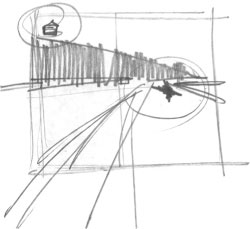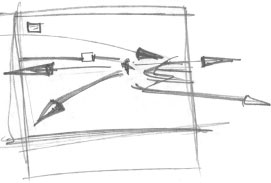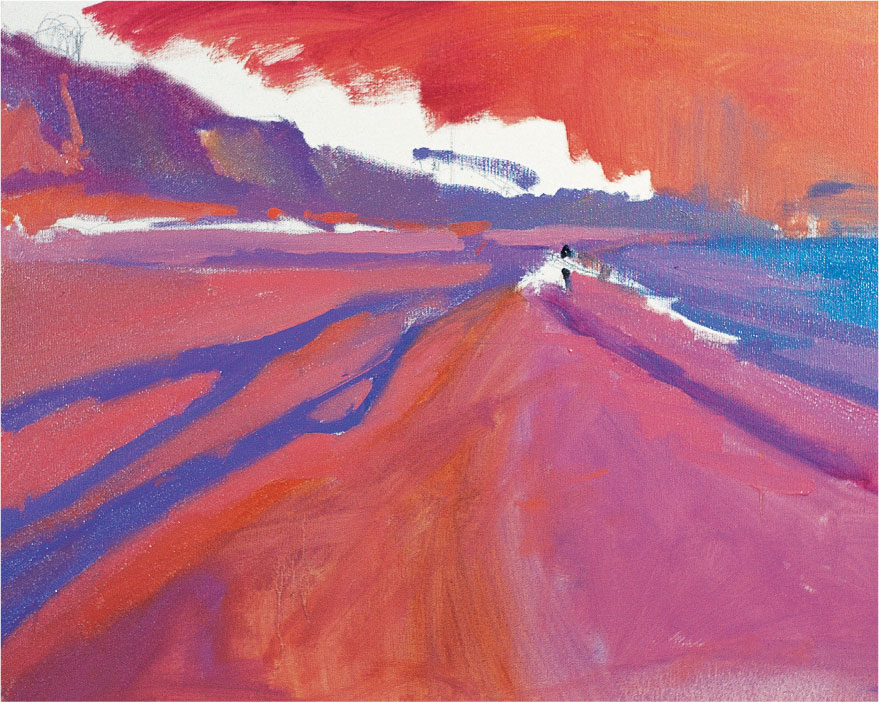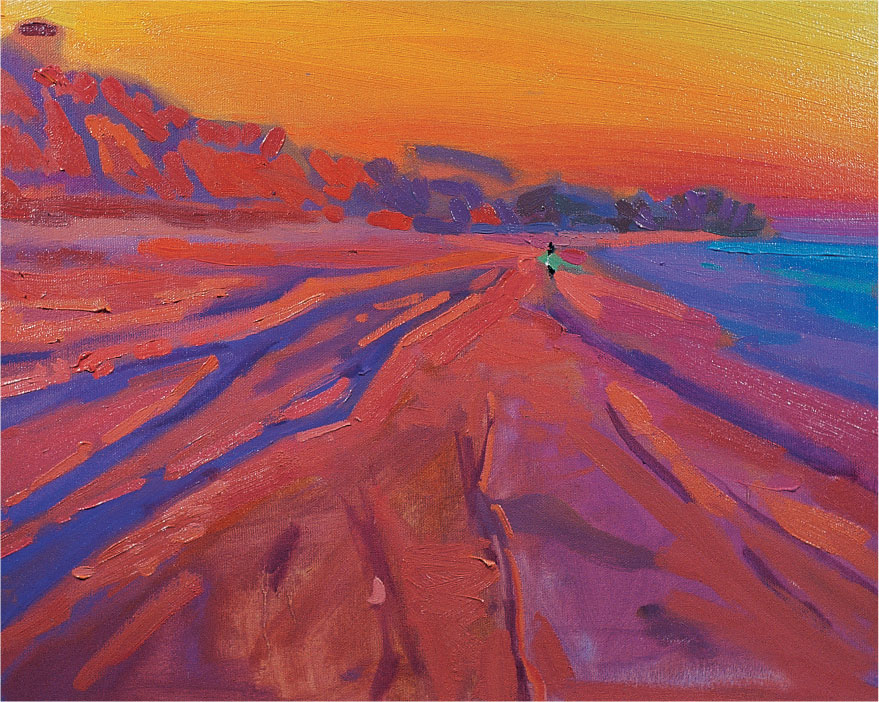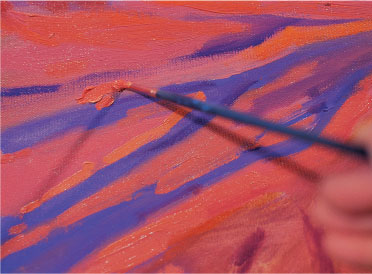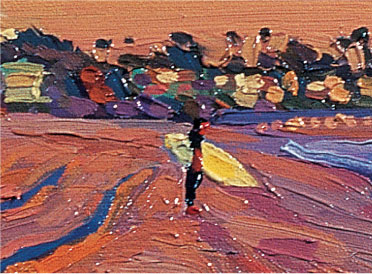Kevin Short’s art training started as a child with watercolors and crayons on the kitchen floor. Years later, he studied painting at the University of New Mexico and Pepperdine University at Malibu, California, and he graduated with honors from Art Center College of Design in Pasadena, California. Kevin now dedicates much of his art to depicting the disappearing vistas of California. Between exhibitions of his work, he teaches workshops and gives demonstrations to beginning and experienced artists alike. Kevin is a member of the American Society of Marine Artists, the California Art Club, the Laguna Plein Air Painters, and Oil Painters of America, and he is also the president of the Capistrano Plein Air Painters’ Association. An international award-winning artist, his artwork is featured in private collections around the world.
SUNSET BEACH
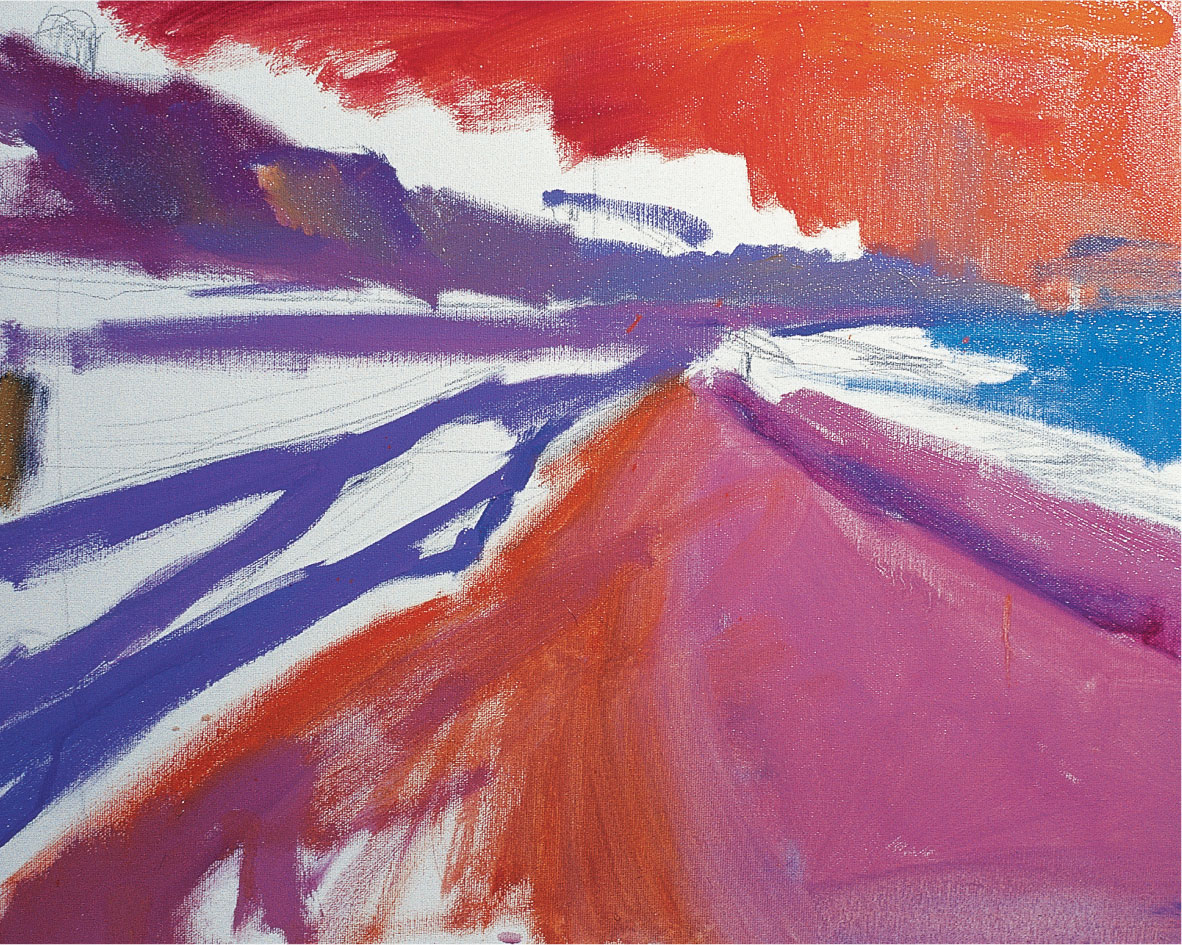
STEP ONE
Using a large filbert brush, I start with a thin mix of the darkest shadow color (Carbazole violet mixed with quinacridone violet, medium blue, and white) and draw over my pencil sketch. I paint the darkest sections first: the shadows of the tracks, the edge of the bluffs, and the surfer (see color sample at right). Then I use pure cadmium red light, quinacridone red, and cadmium orange to block in the sand and sky and medium blue for the ocean. Because this is a sunset scene, the overall tone of the painting is warm, so even the “cool” shadow colors will seem warm next to the warm tones.
Track Shadows

Medium blue, carbazole violet, quinacridone violet, and white
STEP TWO
My goal at this point is to get rid of the white of the canvas by blocking in all the major areas of color. With a medium bristle brush, I scrub in cadmium red light, quinacridone red, and cadmium orange for the sand near the shoreline. I blend in some more cadmium red light and cadmium orange as I paint toward the tire tracks, and I add Carbazole violet to this same mixture to block in the rocky bluffs. Then I mix the sand color with medium blue, phthalo green, and white for the water.
Ocean

Carbazole violet, medium blue, and white

STEP THREE
With a medium round brush, I block in the rest of the sky, blending from top to bottom as I work. I use pure colors here—I can always correct them later if they look too bright. Next I apply cadmium yellow medium with a touch of phthalo green at the top. (This is also the same color I use for the surfboard.) Then I use cadmium orange in the lower half of the sky, and I add a little quinacridone red at the horizon line. The distant ocean is a lavender mix (see color sample above) that I blend up into the sky, adding a little quinacridone red to make it hazy and help create the illusion of depth. The foam on the waves isn’t actually white; the dark part is a greenish blue (phthalo green mixed with white, cadmium yellow medium, and medium blue), and the highlights are pink (quinacridone red mixed with white, and a little cadmium yellow medium). I place all these colors with a small round brush.
STEP FOUR
Next I start working on the distant bluffs. With a small filbert and a combination of phthalo green, cadmium yellow medium, and some of the orange sky mixture from step one, I paint the sides of the middle bluffs. As the bluffs recede into the distance, I add a little more sky color to the blend. For the closest part of the bluffs, I use a rich mixture of cadmium orange, quinacridone red, cadmium yellow medium, and a little white and lay it on thickly with a small filbert. I also mix the sand shadow color into the bluff shadow color to create a third value that I use to further develop the forms of the bluffs.

STEP FIVE
I add the lifeguard tower and distant houses with a mix of cadmium orange, cadmium yellow medium, phthalo green, and a little white. The houses farthest away are a cool, rosy purple (a mix of Carbazole violet and white with a little of the orange sand color). I use a lighter warm orange mix (cadmium orange, cadmium red light, and cadmium yellow medium with white) for the highlights. Using a small filbert and a bright yellow mix of cadmium yellow medium, a touch of phthalo green, and white, I create green highlights on the surfboard to draw the eye directly to the surfer. This complementary highlight will capture the viewer’s eye, much the same way the only two red umbrellas amid hundreds of black umbrellas attract attention. I refine the surfer with a small round brush and a very dark mix of Carbazole violet and phthalo green.
STEP SIX
After standing back and assessing my work, I decide to make some slight alterations. I lighten up the sky by mixing a light creamy color (white, cadmium orange, cadmium yellow medium, and quinacridone violet) directly into the wet sky color and blending it in evenly with a medium round brush. I think the sand needs to be cooler, so I work some blue into the wet paint with a small filbert. The tire tracks need a slightly darker shadow—I mix a dark purple and dab it on top of the tracks, leaving some of the original color showing through. I also change the shape of the tracks slightly, straightening out a few bumps. Since the foreground highlights in this painting are the center of interest, I’ve created them with careful and deliberate strokes and left the other elements in the painting loose and less detailed.
CALIFORNIA COAST

STEP ONE
With a pencil, I draw the horizon line, then the tracks and bushes and the other basic elements, taking care to get the perspective correct. I paint the shadows of the trestle with a mix of Carbazole violet, ultramarine blue, and quinacridone red. As I paint toward the distant part of the trestle, I blend in a mixture of Carbazole violet, ultramarine blue, and white. With a small round brush, I block in the bushes with thick strokes that mimic their growth. As the foliage recedes into the distance, I use less and less blue until I am using a mix of only phthalo green, cadmium yellow medium, Carbazole violet, and white. This color change creates a color pathway that leads the viewer’s eye through the painting, creating extra movement and interest.

STEP TWO
I add a little of the trestle shadow color to the darker mix I used for the bushes and place a few strong shadows in the foreground and near the trestle. I paint in the ocean on the right with a small flat brush and a mixture of ultramarine blue, phthalo green, and white. It looks bright now, but later I’ll add some sky color to tone it down. I stroke in a mix of ultramarine blue, Carbazole violet, quinacridone red, and white onto the track with the same small flat brush. I also add more white and ultramarine blue to cool the mixture as the tracks disappear into the distance. Sometimes I mix colors together directly on my canvas; I find that the new colors that often appear in the blend help the overall color harmony of the painting.

STEP THREE
I block in the mountain and then create a pale yellow mixture for the sky with white, cadmium yellow medium, and ultramarine blue. I mix a lot of this sky color; I’ll save some to blend it into the other color elements later to give the illusion of a very hazy atmosphere. And if an element of the painting “pops” forward too much, I simply add a little sky color to it. I start by first painting the mountain in the distance and then thickly laying on the sky colors with a medium round brush.

STEP FOUR
I blend some of the sky color into the mountain until it starts to disappear, alternating between the two colors. Then I scrub in the sand and add yellow to the edges of the path for variation. I add thick highlights to the bushes with various mixtures of ultramarine blue, cadmium yellow medium, white, and phthalo green. I save the brightest highlights for the foreground; I dab in flowers and highlights with a mix of cadmium yellow medium and a little cadmium orange, white, and phthalo green.
STEP FIVE
Next I add the final sand color. Then I darken the palm tree on the left to bring it forward with a mix of Carbazole violet, ultramarine blue, and phthalo green. I place the two figures with a small round brush and a dark mix of Carbazole violet, quinacridone red, and ultramarine blue. Where the sandy path recedes, I add some sky color to my sand mix near the horizon.

STEP SIX
I add some bright red flowers to the bushes in the foreground with a mix of quinacridone red and white. I also paint in the structure on the right with a few quick strokes. Then I refine the figures by painting their clothes and surfboards and decide I’d like to add one more directional element. I quickly add a surfer going the other direction, and that does the trick.

STEP SEVEN
I finalize the tracks by painting highlights on the gravel. Starting with the track colors I used in step five, I add more quinacridone red and white. I highlight the tracks with more ultramarine blue and white and add a few last bright highlights to the foreground bushes.
Sand

Carbazole violet, quinacridone red, cadmium orange, cadmium yellow medium, and white
Sand Shadows

Carbazole violet, ultramarine blue, quinacridone red, cadmium orange, cadmium yellow medium, and white


